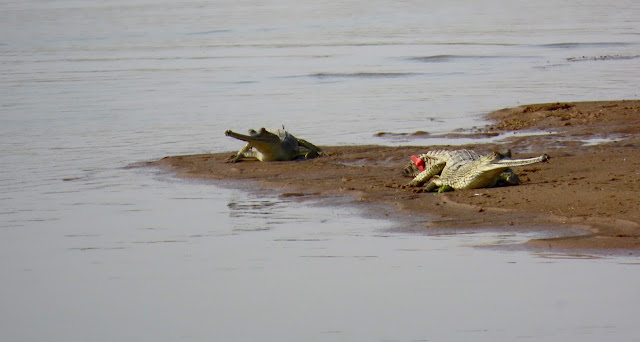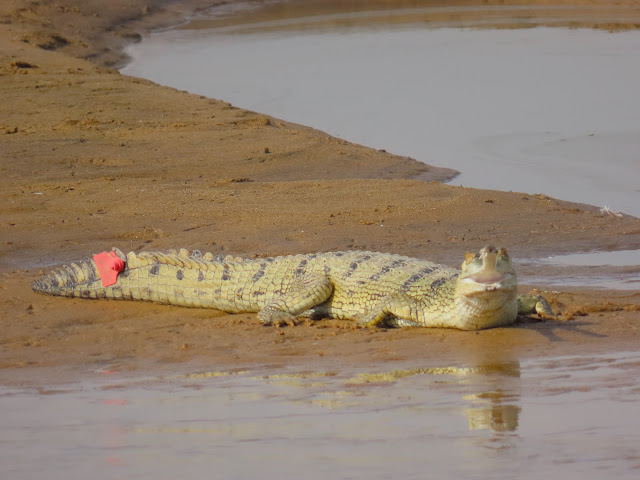 |
| A gharial on the sand bank of the Chambal River. Image credit: Oishimaya Sen Nag |
You may have heard of captive conservation rearing and rehabilitation to save threatened species from extinction. In some species, this conservation measure has been hugely successful. Gharials are one such species. If you wish to witness the implementation of such a conservation measure, and if Crocodilians like the gharial fascinate you, the Gharial Rearing Centre in Deori, Madhya Pradesh, is one place you must visit.
Located in the National Chambal Sanctuary, around 10 km from the town of Morena, Madhya Pradesh, around 19 km from Dholpur, Rajasthan, and around 45 km from the historical city of Gwalior, Madhya Pradesh, this place can be searched on Google Maps as "Eco Centre, Deori, Morena." It is located on the NH44 and remains open all year round from around 9 am to 5 pm. It is a perfect place to visit with family, especially children, to watch the unique and highly threatened gharials in the many hatcheries scattered throughout the centre.
A Brief History Of The Centre
 |
| Entrance to the Gharial Rearing Centre, Deori. Image credit: Arijit Nag |
In the 1970s, it was realised that the gharials were on the brink. Decades of being subjected to habitat destruction, hunting, pollution, etc., had decimated gharial populations across their range in the Indian subcontinent.
Thus, to save the species, the Indian Government launched Project Crocodile in 1975 in collaboration with the UNDP and FAO. As part of this Project, the Gharial Rearing Centre was set up in Deori to raise gharial hatchlings in captivity and release them into the wild in the river later. The centre became part of the National Chambal Sanctuary, which was also set up around that time. The method of rearing gharials in captivity became a huge success, and gharial populations rose significantly. By 1991, however, the Project stopped receiving funding as the authorities believed that the gharial populations were stable. They could not be more wrong.
 |
| Two juvenile gharials in the Chambal River near Dholpur, Rajasthan. Image credit: Oishimaya Sen Nag |
In 2006, the conservation world received a massive jolt. A population study found that gharial populations had dropped down to only around 200!
Once again, there was an urgency to save the gharials. This time, however, conservation efforts were launched in the long term, and the Gharial Rearing Centre at Deori once again played a vital role in conserving this critically endangered species.
Conservation Operations At The Gharial Rearing Centre
Thousands of gharials are raised in the Gharial Rearing Centre to be released into the wild, primarily the Chambal River. The National Chambal Sanctuary staff visit the sand banks of the Chambal around March-April when the female gharials lay their eggs in the sand by digging holes and then covering the eggs with sand. A single clutch has around 18 to 52 eggs. The sanctuary staff remove some of the eggs from each nest, leaving the rest to incubate naturally and carry them to the Gharial Rearing Centre. During this process, care is taken to ensure that the eggs receive the optimal conditions needed to stay healthy.
At the centre, the eggs are incubated in hatcheries designed for the purpose. Upon hatching, which happens after around 60 to 65 days of incubation, the newborn gharials are shifted to a new hatchery. Each gharial is also given a unique identification by a small cut in its tail. A series of hatcheries in the centre houses gharials at various stages of growth. Each hatchery comes with a small pond where the water is regularly changed as gharials are highly sensitive to water quality. Sand is spread around the pond's banks to replicate their riverine habitat. The gharials are also fed fresh fish, which constitutes the majority of their diet in the wild.
 |
| A tagged juvenile gharial in the Chambal River of the National Chambal Sanctuary near Dholpur, Rajasthan. Image credit: Oishimaya Sen Nag |
Once the gharials grow to around 120 cm, when they are about 3 to 4 years old, they are prepared for release in the wild in the nearby Chambal River of the National Chambal Sanctuary. Some of the gharials are radio-tagged to study their behaviour in the wild and gather vital information on gharial ecology.
Visiting The Gharial Rearing Centre
 |
| A signboard educating visitors about gharials at the Gharial Rearing Centre, Deori. |
The Gharial Rearing Centre is open to all, so you can pay a visit and learn about these fascinating Crocodilians who are endemic to the Indian subcontinent. Here, gharials at different stages of growth can be observed basking on the sand of the hatcheries, swimming in the pools, and moving around the hatchery. The Centre also houses some other species like the mugger and tortoises found in the Chambal River.
In addition, the Gharial Rearing Centre also houses a nature interpretation centre and museum that educate visitors about the various species inhabiting the sanctuary and the conservation work done in the centre and the sanctuary.
Writer: Dr. Oishimaya Sen Nag
No comments:
Post a Comment